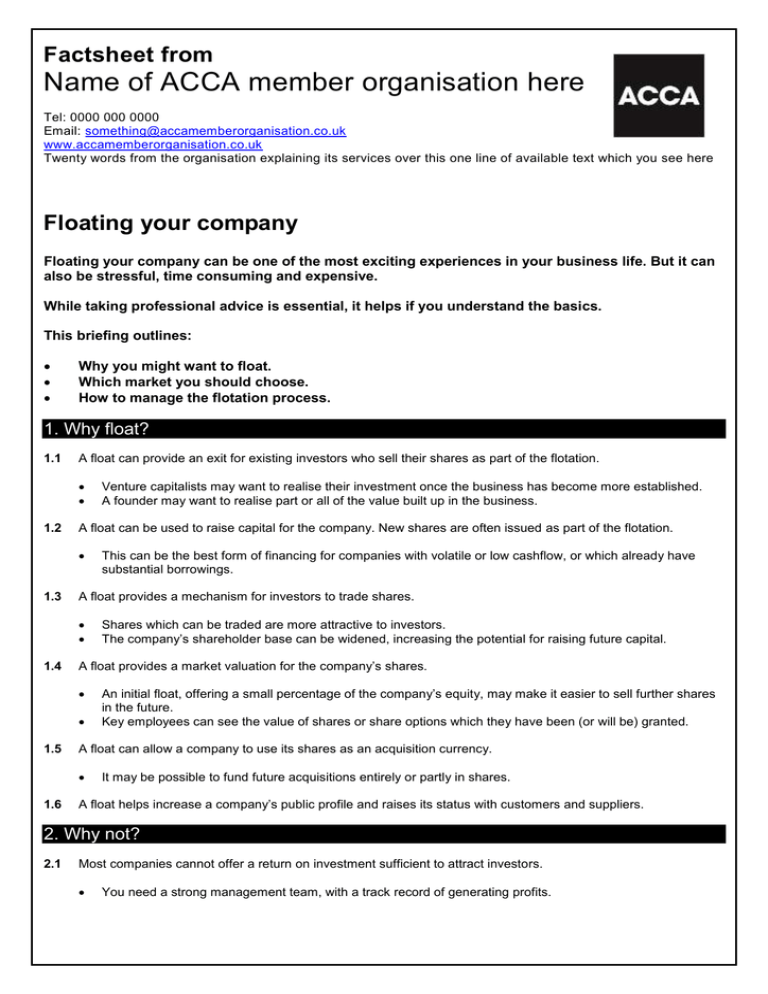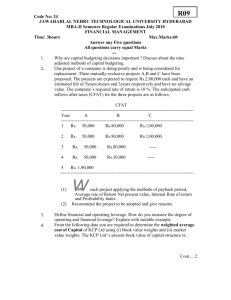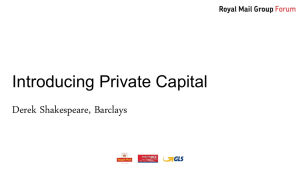
Factsheet from
Name of ACCA member organisation here
Tel: 0000 000 0000
Email: something@accamemberorganisation.co.uk
www.accamemberorganisation.co.uk
Twenty words from the organisation explaining its services over this one line of available text which you see here
Floating your company
Floating your company can be one of the most exciting experiences in your business life. But it can
also be stressful, time consuming and expensive.
While taking professional advice is essential, it helps if you understand the basics.
This briefing outlines:
Why you might want to float.
Which market you should choose.
How to manage the flotation process.
1. Why float?
1.1
A float can provide an exit for existing investors who sell their shares as part of the flotation.
1.2
A float can be used to raise capital for the company. New shares are often issued as part of the flotation.
1.3
An initial float, offering a small percentage of the company’s equity, may make it easier to sell further shares
in the future.
Key employees can see the value of shares or share options which they have been (or will be) granted.
A float can allow a company to use its shares as an acquisition currency.
1.6
Shares which can be traded are more attractive to investors.
The company’s shareholder base can be widened, increasing the potential for raising future capital.
A float provides a market valuation for the company’s shares.
1.5
This can be the best form of financing for companies with volatile or low cashflow, or which already have
substantial borrowings.
A float provides a mechanism for investors to trade shares.
1.4
Venture capitalists may want to realise their investment once the business has become more established.
A founder may want to realise part or all of the value built up in the business.
It may be possible to fund future acquisitions entirely or partly in shares.
A float helps increase a company’s public profile and raises its status with customers and suppliers.
2. Why not?
2.1
Most companies cannot offer a return on investment sufficient to attract investors.
You need a strong management team, with a track record of generating profits.
2.2
Another exit route — particularly a trade sale — may be a better alternative.
2.3
Shareholders may want you to focus on short-term profits, rather than your strategic goals.
Shareholders may want you to become involved in exciting ventures, rather than the opportunities you
favour.
Some shareholders may expect generous, regular dividends, which could undermine cashflow.
You run the risk of losing control of the company altogether.
2.5
A trade sale is usually faster and cheaper than a flotation.
Some companies, particularly mature businesses in non-growth industries or those whose value is largely
based on their assets, may realise a higher price through a trade sale.
You will have a responsibility to satisfy shareholders’ interests, which may not always be in line with your own.
2.4
You must have a viable plan for achieving strong growth in earnings.
Substantial investors may want their own representatives appointed to the board.
If your (and other directors’) shareholdings are diluted, it becomes easier for another business to make a
takeover bid.
There are hidden costs as well as significant cash costs.
Managers can be distracted from running the business during the flotation.
There will be a continuing time cost of dealing with investors afterwards.
2.6
If market conditions change, the float may have to be aborted.
Companies in which shares are traded have to comply with additional regulatory requirements.
You must publish full accounts twice a year, which will allow your competitors to see them.
You must meet accepted standards of corporate governance.
For example, having independent non-executive directors.
You must ensure that important news is promptly communicated to all investors.
For example, changes in your company structure.
Private companies are no longer required to hold an Annual General Meeting (AGM). However, they must
hold one if any director or 10% of shareholders (5% if it is more than 12 months since the last AGM) requests
one.
3. Choosing the market
3.1
For small and growing companies, AIM is a possible choice. Floating this way allows shares to be traded ‘offexchange’.
The requirements for a company to trade on AIM are less stringent than for the Main Market (see 3.2).
The costs of flotation, and the ongoing costs, are lower than for the Main Market.
Private individuals, venture capital trusts and institutions can invest in AIM companies.
Shares traded on growth markets such as AIM will be exempt from Stamp Duty from April 2014.
If the company has been in existence for two years or less, existing shareholders must agree not to sell their
shares for at least one year after flotation.
There must be no restrictions on the free transferability of shares.
There is no minimum percentage of shares that you must make available. However, having fewer shares
available could make the share price volatile.
2
A company may choose initially to float on AIM and move up to the Main Market once the company’s needs
justify it.
3.2
The full Stock Exchange Main Market is generally only suitable for the largest companies with a three-year track
record.
The Main Market is the most high-profile market. Almost all investors will be prepared to invest in shares
quoted on the Main Market (if they appear to be a good investment).
But many larger investors will only invest in companies whose market capitalisation (the total market value of all
the company’s shares) is substantial, say several hundred million pounds.
Costs are considerably higher than floating on AIM.
4. Advisers
4.1
You will need to appoint and retain a corporate adviser.
4.2
Getting a stockbroker is essential if you are looking to raise money, or float on AIM.
4.3
For AIM, your adviser (referred to as a nominated adviser, or Nomad) will need to be on the register of
advisers maintained by the London Stock Exchange.
The stockbroker will help find and interest potential investors.
The stockbroker will help maintain your profile with investors once the company has floated.
Other advisers will need to be involved.
These include your auditor (see 5.1) and your lawyer (see 5.2).
You may want to involve a financial PR company, particularly if you are raising significant amounts of money.
Choose your advisers carefully. Advisers with a better reputation could improve your credibility with investors.
And they are likely to be more thorough, as their reputations are at stake.
5. Preparation
5.1
You must ensure that your annual accounts and reports conform to UK accounting principles, as accepted by the
Stock Exchange.
Since 1 January 2005 they now have to conform to new International Accounting Standards (IAS).
Young businesses that are floating will need to have a business plan.
An accountant’s report on the company’s trading record is normally included in the prospectus.
Before making an application to AIM, you should get a copy of their rules and ensure you meet their
admissions criteria.
If you have no trading record, check with the applications department before going ahead.
5.2
Your company’s legal structure needs to be in order.
5.3
If you are a sole trader, or in a partnership, you will need to form a company.
You must make key information available.
Who the directors are and what service contracts they have with the company.
Who the major shareholders are and what new or existing shares are for sale.
Details of the company’s key contracts.
The memorandum and articles of association. Check there are no unusual restrictions.
3
5.4
You must appoint a CREST-compliant registrar to register the new shares.
5.5
Check the other requirements of the market you choose.
6. Pricing
Pricing a new flotation is complicated. The price may continue to be a matter for negotiation between you and your
corporate adviser or stockbroker right until the last minute.
6.1
Most companies are valued on their historical and expected future earnings.
6.2
Investors will pay more for shares in exciting businesses.
6.3
Your advisers will help put together projections of future earnings.
You can choose whether or not your prospectus contains an earnings forecast (which you must be confident
of meeting or exceeding).
Your company will be more valuable if it is a market leader in its sector. Or if it is involved in a growth or
fashionable industry.
You may choose to sell for a lower price to ensure a successful flotation and provide a good after-market in the
shares.
If you plan future share issues it is important to keep investors keen.
7. The process
7.1
Start by choosing your advisers (see 4) and getting the basics right (see 5).
7.2
Nominate one individual responsible for the flotation (usually the finance director).
7.3
It is useful if that individual has previous experience of a flotation.
Decide what type of flotation you want.
Choose an introduction if you are not looking to raise capital. It is the cheapest and simplest way to float.
An introduction is often used to move from AIM to the Main Market.
In a private placement, shares are offered to selected investors.
In an offer for sale, shares are offered to the public and investing institutions.
An offer for sale is more expensive than a private placement.
7.4
If you are raising money from new investors, you will need a prospectus.
This should set out all the key information about the company and the share offering.
You are legally responsible for the accuracy of information in your prospectus. Be sure to check it carefully.
7.5 The typical timescale from start to successful flotation is at least three mo nths.But it is not unknown for the
process to take 12 months.
Costs
A.
Initial costs can be substantial.
4
B.
You will continue to need advisers after the float.
C.
Advisers’ fees vary depending on the level of work and the size of the company. A small firm will typically pay
between £150,000 and £350,000.
The admission fee for AIM is dependent on your expected market capitalisation when you float.
You will have to pay commission on any new money raised.
You would have had to pay most of these expenses in any case.
A corporate adviser will charge about £25,000 a year.
You will also have to pay an annual fee which depends on your market capitalisation.
Call AIM on Tel 020 7797 3429 for further information.
Employees
A.
A float can be an opportunity to attract and motivate staff.
Employees may be more motivated if they have a stake in the business.
Shares and options can be a tax-efficient part of a remuneration package.
You may be competing for key employees with other companies which offer shares or share options.
A planned flotation at a future date, and the offer of pre-flotation shares or options, can also attract key
employees.
B.
Remuneration in the form of shares or options allows you to reward staff without as great an impact on
cashflow.
A float can also present problems.
Like any change, flotation can face resistance from employees.
A successful flotation may also have demotivating effects. Key employees may feel there is nothing left to
work for, particularly if they are sitting on valuable shares or options.
Before you float, plan how you will motivate and retain them afterwards.
Further information
For more information about AIM and the Main Market, visit www.londonstockexchange.com.
Last reviewed 01.04.13
© BHP Information Solutions 2013. ISSN 1369-1996. All rights reserved. No part of this publication may be reproduced or transmitted without the
written permission of the publisher. This publication is for general guidance only. The publisher, expert contributors and distributor disclaim all liability
for any errors or omissions. Consult your local business support organisation or your professional adviser for help and advice.
5






